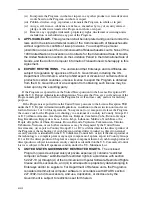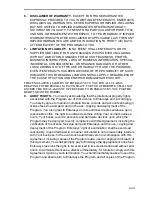
iii
Wireless 4.9 GHz Band Statement:
Installation and operation requires an approved license from the FCC.
Industry Canada - Class B
This digital apparatus does not exceed the Class B limits for radio noise emissions from
digital apparatus as set out in the interference-causing equipment standard entitled “Digital
Apparatus,” ICES-003 of Industry Canada.
Cet appareil numérique respecte les limites de bruits radioélectriques applicables aux
appareils numériques de Classe B prescrites dans la norme sur le matérial brouilleur:
“Appareils Numériques,” NMB-003 édictée par l’Industrie.
Industry Canada Statement
Operation is subject to the following two conditions:
1) This device may not cause interference and
2) This device must accept any interference, including interference that may cause
undesired operation of the device
This device has been designed to operate with an antenna having a maximum gain of
23 dB. Antenna having a higher gain is strictly prohibited per regulations of Industry Canada.
The required antenna Impedance is 50 ohms.
To reduce potential radio interference to other users, the antenna type and its gain should be
so chosen that the EIRP is not more than required for successful communication.
Because high power radars are allocated as primary users (meaning they have priority) in
5250-5350 MHz, these radars could cause interference and/or damage to license exempt
LAN devices.
RBT-4102-EU
Australia/New Zealand AS/NZS 4771
Japan Telec Approval
003NY05152
003GZ05053
003WY05076
003UX05009
A
N826
Summary of Contents for RoamAbout RBT-4102-BG
Page 2: ......
Page 34: ...Hardware Installation 2 4 ...
Page 48: ...Access Point Configuration 3 14 ...
Page 54: ...Network Configuration 4 6 ...
Page 56: ...Troubleshooting A 2 ...
Page 70: ...Specifications C 10 ...






































